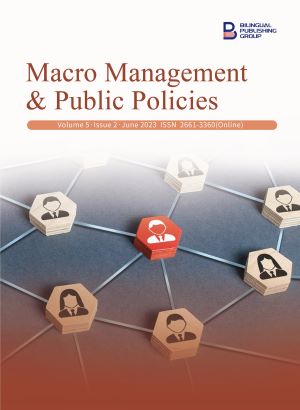-
945
-
352
-
271
-
256
-
237
Profitability Level and Determinants of Tea Intercropping in Taraba State
DOI:
https://doi.org/10.30564/mmpp.v5i2.5702Abstract
Intercropping involves the cultivation of more than one crop on a plot of land at a particular time. Tea intercropping with other crops can increase the profitability of farmers and the development of tea plants. The study estimated the profitability level of intercropped tea farms and determined the factors affecting the profitability of tea intercropping systems in the study area. Information was obtained from two hundred and four tea farmers using a well-structured questionnaire. The analytical techniques used in the study were descriptive analysis and linear regression. The results revealed that the majority (95.6%) of the farmers are from Kakara and Nyiwa towns. There are few (2.9%) women involved in tea farming in Taraba State. 29% of the tea farmers are young less than 30 years and old above 60 years. Fifteen percent of the farmers are single, 83.8% are married and 1.5% are divorced. About 40% of the tea farmers had no formal education, 21% have between 1-6 years of education, 19% had 7-12 years of education and 21% had greater than 12 years of education. The gross margin is ₦289,900,581.9 and the gross margin per farmer is ₦1,421,081.28. The net income is ₦2,879,055,533.3 and the net income per farmer is ₦1,411,301.63. The amount of profit tea farmers make in Taraba State is ₦1,425,001 and the profit per farmer is ₦6,985.30. Labour costs (weeding, pruning, application of insecticide, watering) and cost of materials (cutlass, file, chemical, bag and others) are significant determinants of the profit level of the tea intercropping system in Taraba State. Tea intercropping farming is profitable in Taraba State Nigeria.
Keywords:
Determinants; Intercropping system; Profit; TeaReferences
[1] Sedaghathoor, S., Janatpoor, G., 2012. Study on effect of soybean and tea intercropping on yield and yield components of soybean and tea. ARPN Journal of Agricultural and Biological Science. 7, 664-671.
[2] Waheed, A., Hamid, F.S., Ahmad, N., et al., 2007. Profitability and morphological characters of inter-cropping of different vegetables in tea. Science Technology and Development. 26(3-4), 42-46.
[3] Baruah, S., Ahmed, N., Sulkia, S., 2005. Intercropping in young tea plantation. Natural Product Radiance. 4(1), 35-39.
[4] Sita, K., Rosyadi, A.I., Aji, T.M., 2018. Contract farming through tea-horticulture intercropping system: A case study of Gambung Estate and horticultural farmers in Bandung, Indonesia. Asian Journal of Agriculture and Development. 15(1362-2018-3542), 75-85.
[5] Josepha, M., Collinsa, O., Maryb, O., et al., 2009. Response of Tea (Camellia sinensis) to intercropping with African nightshade (Solanum scabrum). Journal of Agriculture, Pure and Applied Science and Technology. 1(9), 5-11.
[6] Yurteri, A.P.D.E., Küplemez, R.A.H., Seyis, F., 2022. Plant breeding based evaluation of Turkish tea [Camellia Sinensis L.(O.) Kuntze] genetic resources. New Development on Medicinal and Aromatic Plants-II. 227.
[7] Famaye, A.O., 2006. Handbook on tea production in Nigeria. Pamma Press: Akure. pp. 33.
[8] Kunstadter, P., Chapman, E.C., Sabhasri, S., 2019. Farmers in the forest: Economic development and marginal agriculture in northern Thailand. University of Hawaii Press: Honolulu.
[9] Heiss, M.L., Heiss, R.J., 2007. The story of tea: A cultural history and drinking guide. Random House Digital, Inc.: New York.
[10] Majumder, S., Sarkar, S., Ghosh, A., et al., 2022. Photosynthetic organs of wild Indian tea tree are rich in patchouli components: A GC-MS based metabolomics. Natural Product Research. 36(8), 2191-2195.
[11] Ahuja, P.S., Gulati, A., Singh, R.D., et al., 2013. Science of tea technology. Scientific Publishers: Jodhpur. pp. 475.
[12] Liu, J., Zhang, Q., Liu, M., et al., 2016. Metabolomic analyses reveal distinct change of metabolites and quality of green tea during the short duration of a single spring season. Journal of Agricultural and Food Chemistry. 64(16), 3302-3309.
[13] Lighton, D., Guveya, E., Bandason, W., et al., 2014. Socioeconomic determinants of smallholder out-grower tea (Camellia Sinensis) farming profitability in Chipinge District, Zimbabwe. Journal of Agriculture Economics and Rural Development. 150, 156.
[14] Van Ho, B., Nanseki, T., Chomei, Y., 2019. Profit efficiency of tea farmers: Case study of safe and conventional farms in Northern Vietnam. Environment, Development and Sustainability. 21, 1695-1713. DOI: https://doi.org/10.1007/s10668-017-0073-z
[15] Chavas, J.P., Nauges, C., 2020. Uncertainty, learning, and technology adoption in agriculture. Applied Economic Perspectives and Policy. 42(1), 42-53.
[16] Nyakweba, T.O., 2019. Financial service accessibility strategies for farmers’ economic empowerment in Kenya: A survey of small-scale tea farmers in Kisii County [Ph.D. thesis]. Nairobi: Kabarak University.
[17] Oluyole, K.A., Daniel, M.A., Yahaya, A.T., 2017. Diversity in the use of land for tea production and its effects on farmers’ income in Taraba State, Nigeria. Journal of Agriculture and Rural Research. 1(2), 51-55.
Downloads
How to Cite
Issue
Article Type
License
Copyright © 2023 Author(s)

This is an open access article under the Creative Commons Attribution-NonCommercial 4.0 International (CC BY-NC 4.0) License.




 Oladokun Yetunde O.M
Oladokun Yetunde O.M

